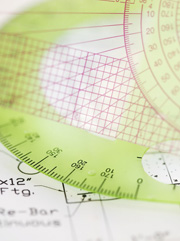| Weather Fact: | Lightning is a powerful part of Earth's weather. A single bolt of lightning is hotter than the sun and in the time it takes to blink, lightning can strike the ground up to five times. |

In this section:
Measuring Windspeed Blowing in the Wind Winds of the World Quiz
Having learned about the power of the wind, this simple experiment will allow you to measure the wind in your location. Using some very simple materials, you can get a surprisingly accurate wind speed reading.

Make sure the experiment takes place in a windy part of the school grounds, away from buildings and other barriers which may block the full force of the wind
You will need:
- Strong thread or thin fishing line – 40cms long
- A ping-pong ball
- A large protractor
- Glue and tape
- Thick Cardboard
What to do:
- Firstly, mount the protractor onto the thick cardboard with the tape, curved side pointing down.
- Tape or glue the thread (or fishing line) to the ping-pong ball
- Tie or glue the other end of the thread to the centre of the protractor
- When the wind blows the thread off centre, read the angle on the protractor
- Use the conversion table below to convert the registered angle to the velocity of the wind.
|
Conversion Table |
||||||||
|
Angle of String |
90 |
80 |
70 |
60 |
50 |
40 |
30 |
20 |
|
Wind Speed (kph) |
0 |
13 |
19 |
24 |
29 |
34 |
41 |
52 |
Further Learning
The readings could be taken over a period of time, and the results compared to official readings from your weather station.
Wind doesn’t just transport weather around the globe; it also brings dust storms, pollen, smoke, debris and pollution.

This experiment is a great way to measure the properties of the wind in your area, and get involved in understanding the impact of pollution on our planet.
You will need:
- Wax paper
- Petroleum jelly/li>
- Hole punch
- String
- Masking tape
- Magnifying glass
What to do:
- Cut strips or squares from the wax paper
- Cover each piece with a thin layer of petroleum jelly
- Punch a hole in some of the strips and tie a piece of string through the hole
- Place the wax paper in a variety of locations around the school grounds. Some can be hung from trees or posts, while others could be taped to fences, walls or signs.
- Leave the wax paper over night, and collect the following day / lesson
- Use a magnifying glass to view the debris and dust that has collected on the paper.
- Document the findings, being sure to include the location of the paper, and the approximate wind speed over the time period.
Further Learning
Discuss both the positive and negative effects of wind dispersal and transportation as a class.
Place some of the paper in an area where there is a lot of traffic, and where there is no traffic, and look at the difference between each sample. Discuss the impact of car exhaust and other pollution on the quality of the air we breathe.
Create a Classroom Quiz using the Winds of the World pages. There are tons of things to learn throughout these pages – from spelling and comprehension to bizarre facts and stats.
Using the Highlighted Glossary terms, Factual Charts and Mini Case Studies you can challenge the class to a quiz. Make the quiz more interesting by splitting the class into teams, and awarding points to the highest scoring team.
Spelling
There are lots of new words associated with this topic area. Here are just a few:
|
Atmosphere |
Anemometer |
Barometer |
|
Cardinal Point |
Coriolis Effect |
Circulating |
|
Equator |
Hemisphere |
Hurricane |
|
Kilometre |
Pressure |
Subtropical |
Facts and Stats
Use the Facts & Stats section to create Fact Cards for the class. Give them 1 or 2 facts to learn, and ask them to tell the class about their interesting fact!
Further Learning
Learn more about the different types of Local Winds, and the science and folk lore behind them:
- Bora
- Pampero
- Andhi
- Santa Ana
- Williwaw
- Zephyr
Ask the class to pick a category, and learn more about where these winds occur and what causes them.
